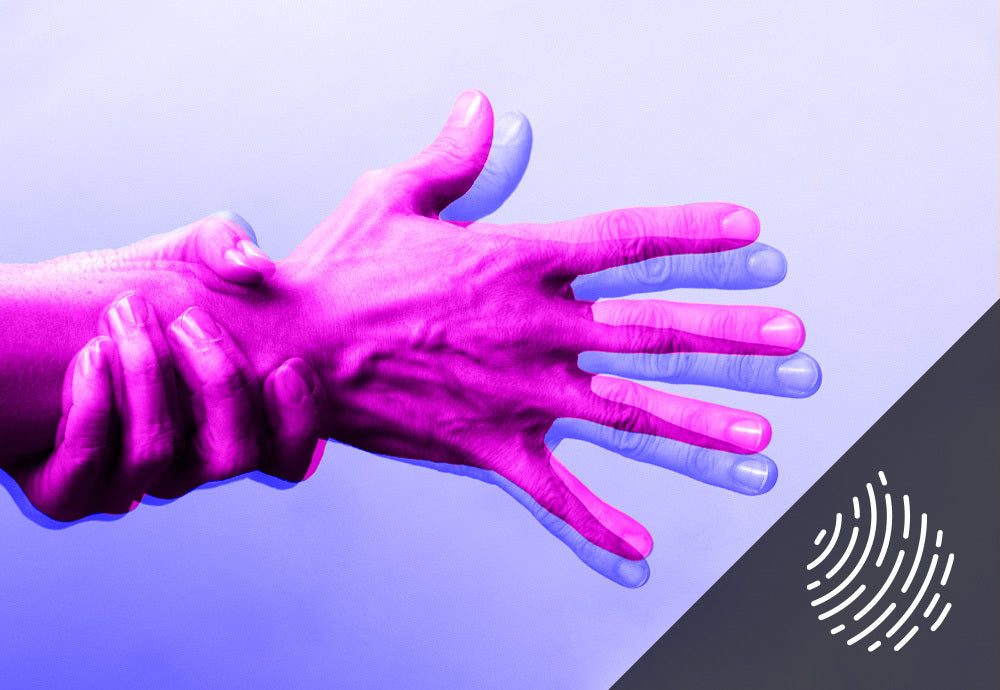Your Cart is Empty
FREE SHIPPING ON ORDERS $70+ | SATISFACTION GUARANTEED
Between stubbed toes, papercuts, and whacked funny bones, it’s safe to say we’ve all experienced pain at some time or another. But bumps and bruises are different from the kind of pain that disrupts your lifestyle. That’s something chronic pain is known for.
Chronic pain is defined as persistent pain lasting for three or more months.
In a 2021 survey, which included results from 2,063 adults in the US, half of participants reported they were currently dealing with chronic pain. And a whopping 73% reported being in pain every day.(1)
These numbers are much higher than reported pre-pandemic pain rates of around 20%.(2)
The survey also found that cannabis, including the cannabinoid CBD, is increasing in popularity for pain management among certain demographics.
If you’re considering any form of cannabis to manage chronic pain, you’re in the right place. We’re running down the facts and figures about pain and exploring cannabis as a remedy.

Some other tidbits from the 2021 survey you might find interesting: How common chronic pain is varies based on age — but not how you might think. So do pain management techniques — including how likely people are to try CBD and cannabis.
Young folks often hear they have lots of aches and pains to look forward to when they get older, but these numbers tell a different story.
According to the survey, 65% of adults aged 18-34 reported chronic pain, while 52% of adults over age 35 reported chronic pain.
There are two main pathways for pain therapy: pharmacological (drug) and non-pharmacological (non-drug). Pain treatment plans usually involve a combination of both, like pairing massage therapy with a pain reliever.
Most people surveyed said they were interested in non-pharma approaches like diet changes and exercise. But over-the-counter pain relievers are by far the most common treatment people reach for when they’re in pain — 53% of survey participants reported using them.
What’s next in line on the pharmacological side? Cannabis.
Overall, people are embracing CBD and other forms of cannabis even more than prescription pain relievers (16% cannabis vs 11% non-opioid pain relievers).
You probably won’t be surprised to learn the generational divide trend continues when it comes to cannabis. Adults aged 18-44 are twice as likely to use it for pain as people aged 45 and over.
So, what’s the deal with this rising pain management star? Should you consider cannabis for your post-pandemic pain management toolkit?
Let’s weed through the facts.
The secret to the pain easing properties of cannabis lies in its cannabinoids, which interact with the body’s endocannabinoid system (ECS). The ECS communicates with other systems to help lower inflammation and reduce pain levels.
Research has shown that cannabinoids may be effective for several types of pain caused by neurological, autoimmune, and inflammatory conditions.(3,4,5)
Cannabinoids have also shown to be helpful for pain without a known cause, such as low back pain.(6)
If you want to learn more about the ECS, addWhat Is The Endocannabinoid System? to your to be read list.
You’ve likely heard of two very popular cannabinoids: THC and CBD.
THC is the main cannabinoid in marijuana that causes a high.
CBD is abundant in hemp and doesn’t have THC’s psychoactive properties.
You may have also heard of another form of THC called delta-8-THC (aka D8), which is climbing up the favorite cannabinoid charts. Its psychoactive effects are less intense than marijuana, which some folks find more appealing.
There are hundreds of cannabinoids, but CBD or THC (including D8) are the pain-busting superstars.
Everyone processes cannabinoids differently, so the best cannabinoid(s) for managing your pain may be different from your neighbor. That said, there are a few ways that CBD, THC, and D8 could be a boon to your pain management plan.
If you’re thinking about adding cannabis to your pain-relieving repertoire, we recommend reading How To Safely Use CBD With Your Medical Treatment Plan.
“As needed” is one approach to using cannabis for pain relief. In these cases, cannabis is used when the pain sets in, kind of like taking an over-the-counter or prescription pain reliever when you need it.
This might look like rubbing some topical CBD cream on an aching back, chewing a D8 gummy to counter a headache, or smoking a joint when an old injury flares up.
Tackling pain as it comes up could be enough. If it’s not, a pain management strategy might be needed.
When pain is constant or consistent, your doctor may recommend an ongoing regimen of pain therapies to keep pain levels manageable.
In these cases, CBD may be an ideal cannabis-based solution because it’s non-intoxicating. Most people can use it on a daily basis while going about their usual business. That said, your healthcare provider might have other recommendations.
Using opioid pain relievers over a period of time can lead to addiction, putting people in chronic pain at a greater risk of becoming dependent.(7)
Cannabis is an option for those looking to avoid or reduce their reliance on opioid pain relievers.
Studies have found using CBD and THC alongside opioids to be more effective than opioids alone for managing cancer-related pain.(8)
When medical cannabis patients who also used opioids were surveyed, 80% said that cannabis was more effective than opioids for pain.
Cannabinoids Vs Prescription Pain Relievers & Mental Health
Physical discomfort isn’t the only concern associated with chronic pain. People with chronic pain are four times more likely to have anxiety or depression.(9)
While relieving pain can make life more enjoyable, simply treating the pain with pain relievers doesn’t always work, in part due to side effects and the risk of addiction.
In addition to its pain-relieving effects, evidence suggests that cannabis may help with depression and anxiety by regulating serotonin and other hormones that affect mood.(10)
Cannabinoids & Non-Pharma Pain Management Therapies
Cannabinoids like CBD also blend well with many non-pharmacological techniques. Many cannabis advocates incorporate CBD, THC, and delta-8 products into their massage, meditation, yoga, and exercise routines. The cannabic kick can amplify mindfulness and movement practices used to help alleviate pain.
To learn more about this, check out these posts:Adding CBD To Massage Therapy,Creating A CBD & Meditation Ritual For Body-Mind Wellness, andCBD + Yoga: A Divine Duo?.
Sadly, it’s not just us humans that deal with sore bodies. Pets get occasional and chronic pain, too. So, it’s worth noting that CBD may also ease your best animal friend’s achy joints and more. Just be sure to get a product made especially for pets because formulations for people can contain ingredients that are harmful to animals.
Pain is more common in the post-COVID world, and younger adults seem to be feeling the worst of it. But no matter how you spin it, pain is prevalent in every generation.
Those looking for solutions might consider following the trend of incorporating cannabis — especially the cannabinoids CBD, THC, and delta-8-THC — into their pain management toolkit. These cannabinoids have properties that may reduce pain and boost mood while reducing reliance on opioid pain relievers.
[INSERT EXPLORE CBD & D8 PRODUCTS BUTTON?]
References
Jonas, W. (2021). Chronic Pain Management post-COVID. Dr. Wayne Jonas. https://drwaynejonas.com/chronic-pain-management-post-covid/
(2020). Chronic Pain and High-impact Chronic Pain Among U.S. Adults, 2019. CDC. https://www.cdc.gov/nchs/products/databriefs/db390.htm
Vučković, S. (2018). Cannabinoids and Pain: New Insights From Old Molecules. Frontiers in Pharmacology. https://www.frontiersin.org/articles/10.3389/fphar.2018.01259/full
Coelho, S. (2021). Does CBD Help Treat Autoimmune Diseases? Healthline. https://www.healthline.com/health/cbd-for-autoimmune-diseases
Atalay, S, et al. (2019). Antioxidative and Anti-Inflammatory Properties of Cannabidiol. Antioxidants. https://doi.org/10.3390/antiox9010021
Senderovich, H, et al. (2021). The Effectiveness of Cannabis and Cannabis Derivatives in Treating Lower Back Pain in the Aged Population: A Systematic Review. Gerontology. https://doi.org/10.1159/000518269
(2022). How opioid addiction occurs. Mayo Clinic. https://www.mayoclinic.org/diseases-conditions/prescription-drug-abuse/in-depth/how-opioid-addiction-occurs/art-20360372
Cherney, K. (2020). Using CBD Oil for Pain Management: Does It Work? Healthline. https://www.healthline.com/health/cbd-oil-for-pain
(2022). Chronic Pain And Mental Health. Mental Health America. https://www.mhanational.org/chronic-pain-and-mental-health#ONE
Ferguson, S. (2021). Can Medical Cannabis Ease Anxiety and Depression Symptoms? PsychCentral. https://psychcentral.com/depression/medical-marijuana-for-anxiety-and-depression

The cannabis compound CBD has been popping up in Parkinson’s disease (PD) therapy and prevention conversations, propelled by success stories from p...
Read More
CBD is one of the most popular supplements on the market today. But you're a savvy consumer. You know just because something is popular doesn’t mea...
Read More
You know delta-8 as "weed-lite" or the "chillest of the cannabinoids." But what about all the potential health benefits of this unique compound? Wh...
Read More